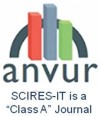Abstract
Keywords
Full Text:
PDFDOI: http://dx.doi.org/10.2423/i22394303v10n2p117
References
Accame, M., & Dell’Oro, E. (2004). I Mirabilia Urbis Romae. Roma, Italy: Tored.
Angelidou, M., & Psaltoglou, A. (2019). Social innovation, games and urban planning: An analysis of current approaches. International Journal of Electronic Governance, 11(1), 5–22. https://doi.org/10.1504/IJEG.2019.098807
Aroni, G. (2019). The Architecture of Assassin’s Creed II’s Florence: An Analysis with the History-Game Relations (HGR) Framework. Well Played, 8(1), 13-26. https://doi.org/10.1184/R1/7680920
Bailey, K. (2015, March 14). Filling in the Corners: Bringing Assassin’s Creed’s Historical Worlds. Retrieved September 22, 2020, from Archive.is website: http://archive.is/JCC1o
Barsalou, L. W. (2008). Grounded Cognition. Annual Review of Psychology, 59(1), 617–645. https://doi.org/10.1146/annurev.psych.59.103006.093639
Barsalou, L. W., Simmons, W. K., Barbey, A. K., & Wilson, C. D. (2003). Grounding conceptual knowledge in modality-specific systems. Trends in Cognitive Sciences, 7(2), 84–91. https://doi.org/10.1016/S1364-6613(02)00029-3
Bevilacqua, M. (2012). L’immagine di Roma moderna da Bufalini a Nolli – Un modello europeo. In Piante di Roma dal Rinascimento ai catasti (pp. 63–95). Roma, Italy: Artemide.
Bevilacqua, M. (2018). L’immagine di Roma moderna da Bufalini a Nolli – Un modello europeo. Roma, Italy: Artemide.
Boes, K., Buhalis, D., & Inversini, A. (2016). Smart tourism destinations: Ecosystems for tourism destination competitiveness. International Journal of Tourism Cities, 2(2), 108–124. https://doi.org/10.1108/IJTC-12-2015-0032
Bowden, O. (2017). Assassin’s Creed. Peguin. Retrieved from /books/305782/assassin-s-creed/9781405932110
Buhalis, D., & Amaranggana, A. (2015). Smart Tourism Destinations Enhancing Tourism Experience Through Personalisation of Services. In I. Tussyadiah & A. Inversini (Eds.), Information and Communication Technologies in Tourism 2015 (pp. 377–389). Cham: Springer International Publishing. https://doi.org/10.1007/978-3-319-14343-9_28
Cagiltay, N. E. (2007). Teaching software engineering by means of computer-game development: Challenges and opportunities. British Journal of Educational Technology, 38(3), 405–415. https://doi.org/10.1111/j.1467-8535.2007.00705.x
Casas, A. P. (2016). Los límites de la ficción: Narrativa y estética de Los Borja en el videojuego Assassin’s Creed: Brotherhood. Revista Borja. Revista de l’Institut Internacional d’Estudis Borgians, (5), 1–10.
Chan, C. S. (1997). Virtual Reality in Architectural Design. In CAADRIA 1997 Workshop (pp. 1–10). Taipei, Taiwan: Hu’s Publisher Inc.
Chang, Y. C., Peng, H. Y., & Chao, H. C. (2010). Examining the effects of learning motivation and of course design in an instructional simulation game. Interactive Learning Environments, 18(4), 319–339. https://doi.org/10.1080/10494820802574270
Coffrey, R. (1997, September 17). Versailles 1685. Retrieved September 25, 2020, from Computer Gaming World. website: https://www.gamespot.com/games/versailles-1685/
Connolly, T. M., Stansfield, M., & Hainey, T. (2007). An application of games-based learning within software engineering. British Journal of Educational Technology, 38(3), 416–428. https://doi.org/10.1111/j.1467-8535.2007.00706.x
Conzen, M. R. G. (1960). Alnwick, Northumberland: A Study in Town-plan Analysis. London, England: George Philip & Son.
Dondlinger, M. J. (2007). Educational Video Game Design: A Review of the Literature. Journal of Applied Educational Technology, 4(1), 21–31.
Dove, G. (2011). On the need for Embodied and Dis-Embodied Cognition. Frontiers in Psychology, 1, 1–13. https://doi.org/10.3389/fpsyg.2010.00242
Dow, D. N. (2013). Anachronism, Simulation, and Art History in Assassin’s Creed II. In Playing with the Past: Digital games and the simulation of history (pp. 215–232). London, England: Bloomsbury Academic. https://doi.org/10.5040/9781628928259
Ebner, M., & Holzinger, A. (2007). Successful implementation of user-centered game based learning in higher education: An example from civil engineering. Computers & Education, 49(3), 873–890. https://doi.org/10.1016/j.compedu.2005.11.026
Esteban-Espinosa, G. (2020). Relaciones narrativas entre las partes interactivas y las cinemáticas en el videojuego mediante el análisis cualitativo de siete títulos de la saga Assassin’s Creed. Revista Mediterránea de Comunicación, 11(1), 107–116. https://doi.org/10.14198/MEDCOM2020.11.1.4
Fondo para el Desarrollo de los Pueblos Indígenas de América Latina y El Caribe, FILAC. (2020). Unesco: La pandemia del covid-19 resalta la desigualdad en la educación. UNESCO. Retrieved from UNESCO website: https://www.filac.org/wp/comunicacion/actualidad-indigena/unesco-la-pandemia-del-covid-19-resalta-la-desigualdad-en-la-educacion/
Foreman, J. (2004). Game-Based Learning: How to Delight and Instruct in The 21st Century. EDUCAUSE Review, 39(5). Retrieved from https://www.learntechlib.org/p/98263/
Gauthier, P., & Gilliland, J. (2006). Mapping urban morphology: A classification scheme for interpreting contributions to the study of urban form. Urban Morphology, 10(1), 41–50.
Geropanta, V., & Cornelio Marì, E. M. (2014). Defining smart space: Scales of interaction between architecture and social practices. Smart City: città, tecnologia, comunicazione, 10, 165–181.
Hwang, G.-J., & Wu, P.-H. (2012). Advancements and trends in digital game-based learning research: A review of publications in selected journals from 2001 to 2010. British Journal of Educational Technology, 43(1), E6–E10. https://doi.org/10.1111/j.1467-8535.2011.01242.x
Juul, J. (2011). Half-Real. Boston, Massachusetts: The MIT Press.
Khan, M. S., Woo, M., Nam, K., & Chathoth, P. K. (2017). Smart City and Smart Tourism: A Case of Dubai. Sustainability, 9(12), 2279. https://doi.org/10.3390/su9122279
Kiili, K. (2007). Foundation for problem-based gaming. British Journal of Educational Technology, 38(3), 394–404. https://doi.org/10.1111/j.1467-8535.2007.00704.x
Kinney, D. (1990). Mirabilia urbis Romae. The Classics in the Middle Ages : Papers of the Twentieth Annual Conference of the Center for Medieval and Early Renaissance Studies, 1100–1200. New York, NY: Medieval & Renaissance Texts & Studies.
Komninos, N. (2002). Intelligent Cities: Innovation, Knowledge Systems and Digital Spaces. London, England: Routledge. https://doi.org/10.4324/9780203857748
Kropf, K. (2014). Ambiguity in the definition of built form. Urban Morphlogy, 18(1), 41–57.
Labonté, R., & Laverack, G. (2008). Health Promotion in Action: From Local to Global Empowerment. London, England: Palgrave Macmillan. https://doi.org/10.1057/9780230228375
Levy, A. (1999). Urban morphology and the problem of the modern urban fabric: Some questions for research. Urban Morphlogy, 3(2), 79–85.
Liu, T.-Y., & Chu, Y.-L. (2010). Using ubiquitous games in an English listening and speaking course: Impact on learning outcomes and motivation. Computers & Education, 55(2), 630–643. https://doi.org/10.1016/j.compedu.2010.02.023
Lynch, K. (1960). The Image of the City. Boston, Massachusetts: The MIT Press.
Maffei, L., & Caniggia, G. (1981). Composizione architettonica e tipologia edilizia vol. 1 lettura dell’edilizia di base. Venezia, Italy: Marsilio.
Monkey Island Special Edition Collection,. (2011). Play Generation, 72, 59.
Morales, N., & Elisa, M. (2018). La arquitectura como elemento narrativo en Assassins Creed II. Quaderns de Cine., 13, 93–102. https://doi.org/10.14198/QdCINE.2018.13.08
Oliveira, V. (2016). Urban Morphology: An Introduction to the Study of the Physical Form of Cities. Cham, Switzerland: Springer International Publishing. https://doi.org/10.1007/978-3-319-32083-0_1
Papastergiou, M. (2009). Digital Game-Based Learning in high school Computer Science education: Impact on educational effectiveness and student motivation. Computers & Education, 52(1), 1–12. https://doi.org/10.1016/j.compedu.2008.06.004
Plass, J., Homer, B., & Kinzer, C. (2016). Foundations of Game-Based Learning: Educational Psychologist: Educational Psychologist, 50(4), 258–283. https://doi.org/10.1080/00461520.2015.1122533
Ponce Lara, C. E. (2017). Gamificación en Ecuador: ¿los juegos pueden ser parte de procesos educativos y laborales? (Universidad de las Américas). Universidad de las Américas, Quito. Retrieved from http://dspace.udla.edu.ec/handle/33000/8141
Rodríguez Alvarado, C., & Hernández Belmonte, U. (2018). Estudio de la experiencia de usuario en videojuegos serios con contexto artístico. JÓVENES EN LA CIENCIA, 4(1), 1911–1915.
Russell, D., & Laffey, J. M. (2015). Handbook of Research on Gaming Trends in P-12 Education. IGI Global. Retrieved from http://doi:10.4018/978-1-4666-9629-7
Seif El-Nasr, M., Al-Saati, M., Niedenthal, S., & Milam, D. (2008). Assassin’s Creed: A Multi-Cultural Read. Loading..., 2(3), 1–32.
Shaffer, D. W., Squire, K. R., Halverson, R., & Gee, J. P. (2005). Video Games and the Future of Learning: Phi Delta Kappan, 87(2), 105–111. https://doi.org/10.1177/003172170508700205
Shaw, A. (2015). The Tyranny of Realism: Historical accuracy and politics of representation in Assassin’s Creed III. Loading..., 9(14), 4–24.
Silva, D. F. da. (2020). Videogames e espacialidade: A abertura do jogo como potencial para o campo da arquitetura / Video games and spatiality: Opening the game as potential for the field of architecture. Brazilian Applied Science Review, 4(2), 510–528. https://doi.org/10.34115/basrv4n2-009
Squire, K. (2011). Video Games and Learning: Teaching and Participatory Culture in the Digital Age. Technology, Education--Connections (the TEC Series). In Teachers College Press. New York, NY: Teachers College Press.
Stouhi, D. (2020, June 16). From Backdrop to Spotlight: The Significance of Architecture in Video Game Design. Retrieved September 22, 2020, from ArchDaily website: https://www.archdaily.com/938307/from-backdrop-to-spotlight-the-significance-of-architecture-in-video-game-design
Szrajber, R., Guzek, K., & Jach, S. (n.d.). Architectural heritage and its representation in video games. Retrieved from https://cutt.ly/wf1IAQ0
Tüzün, H., Yılmaz-Soylu, M., Karakuş, T., İnal, Y., & Kızılkaya, G. (2009). The effects of computer games on primary school students’ achievement and motivation in geography learning. Computers & Education, 52(1), 68–77. https://doi.org/10.1016/j.compedu.2008.06.008
Van Eck, R., & Dempsey, J. (2002). The effect of competition and contextualized advisement on the transfer of mathematics skills a computer-based instructional simulation game. Educational Technology Research and Development, 50(3), 23–41. https://doi.org/10.1007/BF02505023
van Nuenen, T. (2017). Touring the Animus: Assassin’s Creed and chronotopical movement. Loading..., 10(17), 22–39.
Vivancos, A. E., Ferrer, L. A., & López, A. J. G. (2017). Videojuegos, historia y patrimonio: Primeros resultados de una investigación educativa evaluativa en educación secundaria. Revista Interuniversitaria de Investigación en Tecnología Educativa, 2, 28–40. https://doi.org/10.6018/riite/2017/283801
Waal, M. de, Lange, M. de, & Bouw, M. (2017). The Hackable City: Citymaking in a Platform Society. Architectural Design, 87(1), 50–57. https://doi.org/10.1002/ad.2131
Walker, D. F. (1990). Fundamentals of curriculum. San Diego, California: Harcourt Brace Jovanovich.
Webster, A. (2014, October 31). Building a better Paris in Assassin’s Creed Unity. Retrieved September 22, 2020, from The Verge website: https://www.theverge.com/2014/10/31/7132587/assassins-creed-unity-paris
Westin, J., & Hedlund, R. (2016). Polychronia – negotiating the popular representation of a common past in Assassin’s Creed. Journal of Gaming & Virtual Worlds, 8(1), 3–20. https://doi.org/10.1386/jgvw.8.1.3_1
Xu, F., Weber, J., & Buhalis, D. (2013). Gamification in Tourism. In Z. Xiang & I. Tussyadiah (Eds.), Information and Communication Technologies in Tourism 2014 (pp. 525–537). Cham. Switzerland: Springer International Publishing. https://doi.org/10.1007/978-3-319-03973-2_38
Zoido Naranjo, F., de la Vega, S., Morales, G., Mas, R., & Lois, R. C. (2000). Diccionario de geografía urbana, urbanismo y ordenación del territorio (1a. Ed.). Barcelo, Spain: Editorial Ariel. Retrieved from http://up-rid2.up.ac.pa:8080/xmlui/handle/123456789/1820
Article Metrics
Metrics powered by PLOS ALM
Refbacks
- There are currently no refbacks.
Copyright (c) 2020 Riccardo Porreca, Vasiliki Geropanta, Karen Abril, Dario Giordanelli

This work is licensed under a Creative Commons Attribution-NonCommercial-NoDerivatives 4.0 International License.
SCIRES-IT, e-ISSN 2239-4303
Journal founded by Virginia Valzano





